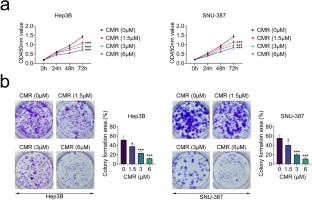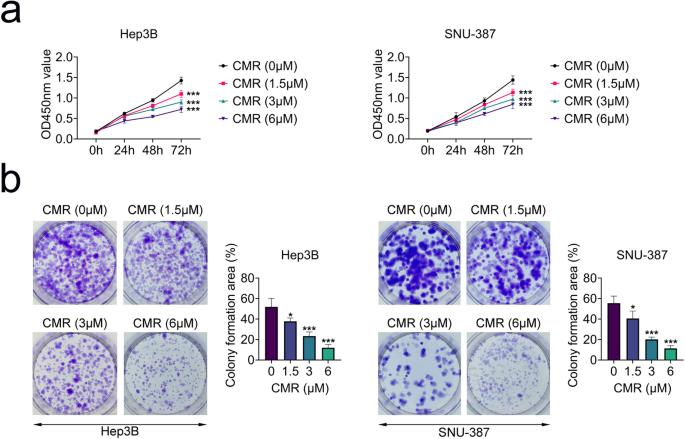Chalcomoracin 可促进肝癌细胞的凋亡和内质网应激。
IF 2.1
4区 医学
Q3 BIOTECHNOLOGY & APPLIED MICROBIOLOGY
引用次数: 0
摘要
Chalcomoracin (CMR) 是一种从桑叶中提取的 Diels-Alder 加合物,具有广泛的抗癌活性。在此,我们旨在探索 CMR 的功能及其在肝细胞癌(HCC)中的作用。我们培养了人类 HCC 细胞系 Hep3B 和 SNU-387,并用不同浓度的 CMR(1.5、3 和 6 µM)进行处理。随后,在体外研究了 CMR 对细胞活力、集落形成、凋亡、迁移和侵袭能力的影响。此外,还使用 Western 印迹法检测了 CMR 暴露下细胞中内质网(ER)应激相关蛋白和丝裂原活化蛋白激酶(MAPK)通路相关蛋白的水平。体内实验研究了 CMR 对 HCC 肿瘤生长的影响。CMR抑制了Hep3B和SNU-387细胞的活力、克隆生成、迁移和侵袭能力,并促进了细胞凋亡和ER应激。此外,CMR 还能降低 MAPK 通路中 ERK、P38 和 JNK 的磷酸化水平。此外,一项体内研究表明,服用 CMR 可以抑制 HCC 的肿瘤发生和 MAPK 通路的活性。我们的数据表明,CMR 有可能通过抑制 MAPK 通路来抑制 HCC 的发展。这些研究结果表明,CMR 作为一种抗癌剂在未来的 HCC 治疗中具有广阔的应用前景。本文章由计算机程序翻译,如有差异,请以英文原文为准。


Chalcomoracin promotes apoptosis and endoplasmic reticulum stress in hepatocellular carcinoma cells
Chalcomoracin (CMR), a Diels-Alder adduct obtained from mulberry leaves, demonstrated wide-spectrum anti-cancer activity. Herein, we aimed to explore the function of CMR and how it works in hepatocellular carcinoma (HCC). Human HCC cell lines Hep3B and SNU-387 were cultured and treated with various concentrations of CMR (1.5, 3, and 6 µM). Subsequently, the effects of CMR on cell viability, colony formation, apoptosis, migration, and invasion abilities were studied in vitro. Furthermore, the levels of endoplasmic reticulum (ER) stress-related proteins and mitogen-activated protein kinase (MAPK) pathway-related proteins in cells under CMR exposure were detected using western blot. Experiments in vivo were conducted to examine the effects of CMR on tumor growth in HCC. CMR administration inhibited the viability and clonogenic, migration, and invasion abilities, as well as promoted cell apoptosis and ER stress in Hep3B and SNU-387 cells. In addition, CMR treatment reduced the phosphorylation levels of ERK, P38, and JNK in the MAPK pathway. Moreover, an in vivo study showed that CMR administration could inhibit tumorigenesis and MAPK pathway activity in HCC. Our data indicate that CMR has the potential to inhibit the development of HCC, potentially through the inhibition of the MAPK pathway. These findings suggest that CMR may have promising applications as an anticancer agent in future therapeutics for HCC.
求助全文
通过发布文献求助,成功后即可免费获取论文全文。
去求助
来源期刊

Journal of Antibiotics
医学-免疫学
CiteScore
6.60
自引率
3.00%
发文量
87
审稿时长
1 months
期刊介绍:
The Journal of Antibiotics seeks to promote research on antibiotics and related types of biologically active substances and publishes Articles, Review Articles, Brief Communication, Correspondence and other specially commissioned reports. The Journal of Antibiotics accepts papers on biochemical, chemical, microbiological and pharmacological studies. However, studies regarding human therapy do not fall under the journal’s scope. Contributions regarding recently discovered antibiotics and biologically active microbial products are particularly encouraged. Topics of particular interest within the journal''s scope include, but are not limited to, those listed below:
Discovery of new antibiotics and related types of biologically active substances
Production, isolation, characterization, structural elucidation, chemical synthesis and derivatization, biological activities, mechanisms of action, and structure-activity relationships of antibiotics and related types of biologically active substances
Biosynthesis, bioconversion, taxonomy and genetic studies on producing microorganisms, as well as improvement of production of antibiotics and related types of biologically active substances
Novel physical, chemical, biochemical, microbiological or pharmacological methods for detection, assay, determination, structural elucidation and evaluation of antibiotics and related types of biologically active substances
Newly found properties, mechanisms of action and resistance-development of antibiotics and related types of biologically active substances.
 求助内容:
求助内容: 应助结果提醒方式:
应助结果提醒方式:


